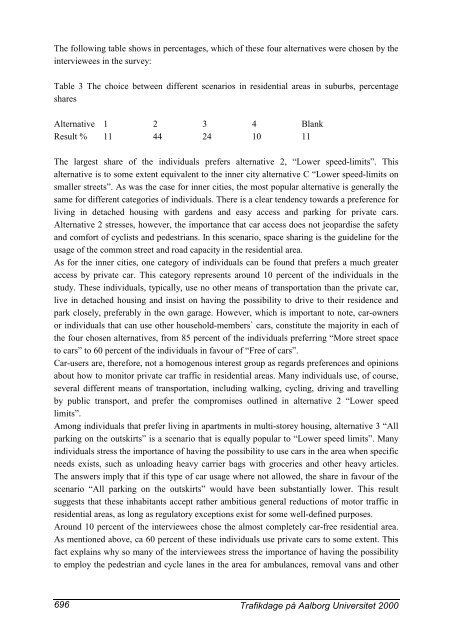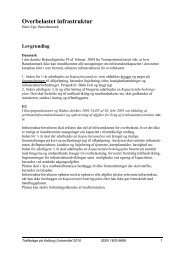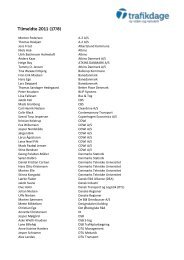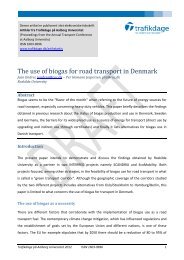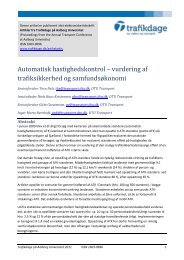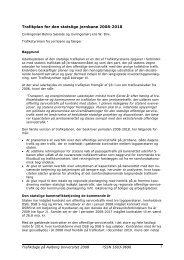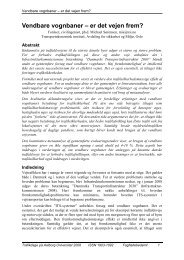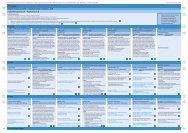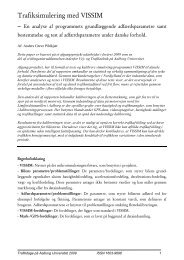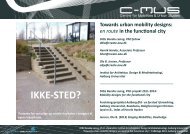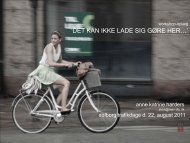Hent paperet som PDF-fil - Trafikdage.dk
Hent paperet som PDF-fil - Trafikdage.dk
Hent paperet som PDF-fil - Trafikdage.dk
You also want an ePaper? Increase the reach of your titles
YUMPU automatically turns print PDFs into web optimized ePapers that Google loves.
The following table shows in percentages, which of these four alternatives were chosen by the<br />
interviewees in the survey:<br />
Table 3 The choice between different scenarios in residential areas in suburbs, percentage<br />
shares<br />
Alternative 1 2 3 4 Blank<br />
Result % 11 44 24 10 11<br />
The largest share of the individuals prefers alternative 2, “Lower speed-limits”. This<br />
alternative is to <strong>som</strong>e extent equivalent to the inner city alternative C “Lower speed-limits on<br />
smaller streets”. As was the case for inner cities, the most popular alternative is generally the<br />
same for different categories of individuals. There is a clear tendency towards a preference for<br />
living in detached housing with gardens and easy access and parking for private cars.<br />
Alternative 2 stresses, however, the importance that car access does not jeopardise the safety<br />
and comfort of cyclists and pedestrians. In this scenario, space sharing is the guideline for the<br />
usage of the common street and road capacity in the residential area.<br />
As for the inner cities, one category of individuals can be found that prefers a much greater<br />
access by private car. This category represents around 10 percent of the individuals in the<br />
study. These individuals, typically, use no other means of transportation than the private car,<br />
live in detached housing and insist on having the possibility to drive to their residence and<br />
park closely, preferably in the own garage. However, which is important to note, car-owners<br />
or individuals that can use other household-members` cars, constitute the majority in each of<br />
the four chosen alternatives, from 85 percent of the individuals preferring “More street space<br />
to cars” to 60 percent of the individuals in favour of “Free of cars”.<br />
Car-users are, therefore, not a homogenous interest group as regards preferences and opinions<br />
about how to monitor private car traffic in residential areas. Many individuals use, of course,<br />
several different means of transportation, including walking, cycling, driving and travelling<br />
by public transport, and prefer the compromises outlined in alternative 2 “Lower speed<br />
limits”.<br />
Among individuals that prefer living in apartments in multi-storey housing, alternative 3 “All<br />
parking on the outskirts” is a scenario that is equally popular to “Lower speed limits”. Many<br />
individuals stress the importance of having the possibility to use cars in the area when specific<br />
needs exists, such as unloading heavy carrier bags with groceries and other heavy articles.<br />
The answers imply that if this type of car usage where not allowed, the share in favour of the<br />
scenario “All parking on the outskirts” would have been substantially lower. This result<br />
suggests that these inhabitants accept rather ambitious general reductions of motor traffic in<br />
residential areas, as long as regulatory exceptions exist for <strong>som</strong>e well-defined purposes.<br />
Around 10 percent of the interviewees chose the almost completely car-free residential area.<br />
As mentioned above, ca 60 percent of these individuals use private cars to <strong>som</strong>e extent. This<br />
fact explains why so many of the interviewees stress the importance of having the possibility<br />
to employ the pedestrian and cycle lanes in the area for ambulances, removal vans and other<br />
696<br />
<strong>Trafikdage</strong> på Aalborg Universitet 2000


